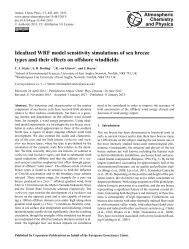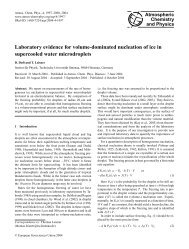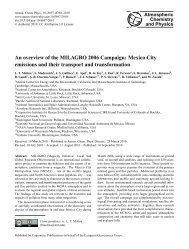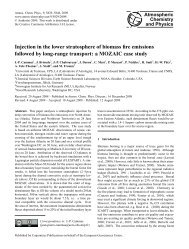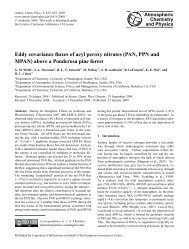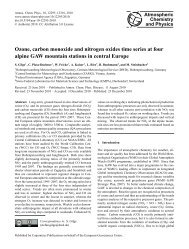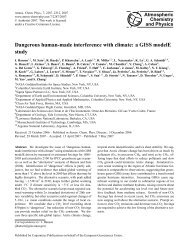A modified band approach for the accurate calculation of online ...
A modified band approach for the accurate calculation of online ...
A modified band approach for the accurate calculation of online ...
Create successful ePaper yourself
Turn your PDF publications into a flip-book with our unique Google optimized e-Paper software.
4138 J. E.Williams et al.: Online photolysis in Chemical Transport Models<br />
<strong>the</strong> <strong>calculation</strong> <strong>of</strong> J values is mandatory, <strong>the</strong>re is also <strong>the</strong> requirement<br />
<strong>of</strong> computational efficiency, which <strong>of</strong>ten requires<br />
<strong>the</strong> use <strong>of</strong> fast and concise methods in which to calculate J<br />
values, thus avoiding excessive runtimes. There<strong>for</strong>e, ra<strong>the</strong>r<br />
than using an infinite number <strong>of</strong> points which cover <strong>the</strong> entire<br />
spectral range it is necessary to introduce a spectral grid<br />
which divides <strong>the</strong> spectral range into a finite number <strong>of</strong> bins<br />
onto which σ and φ values maybe interpolated (e.g. Brühl<br />
and Crutzen, 1988; Kylling et al., 1995). However, solving<br />
<strong>the</strong> radiative transfer equation <strong>for</strong> each spectral bin individually<br />
is still prohibitively expensive, even when using <strong>the</strong><br />
fastest super-computers, which necessitates <strong>the</strong> use <strong>of</strong> fur<strong>the</strong>r<br />
parameterisations. Thus, values <strong>of</strong> Fact are commonly calculated<br />
<strong>of</strong>fline in many CTM’s. These Fact values are usually<br />
derived using standard atmospheres under clear-sky conditions,<br />
meaning that in many instances, <strong>the</strong> effect <strong>of</strong> clouds<br />
and aerosols on photolysis rates is not accounted <strong>for</strong> <strong>accurate</strong>ly.<br />
Such values are <strong>of</strong>ten stored as <strong>of</strong>fline look-up tables<br />
which are indexed using atmospheric parameters such as <strong>the</strong><br />
θ, temperature, pressure, <strong>the</strong> concentration <strong>of</strong> overhead O3<br />
and geometric height (e.g. Brasseur et al., 1998; Kouker et<br />
al., 1999; Bregman et al., 2000). However, such an <strong>approach</strong><br />
can be ra<strong>the</strong>r inflexible if regular updates are needed to input<br />
parameters such as absorption coefficients, where <strong>the</strong> re<strong>calculation</strong><br />
<strong>of</strong> large look-up tables is <strong>of</strong>ten undesirable.<br />
Recently several different methods have been developed<br />
which avoid <strong>the</strong> sole use <strong>of</strong> look-up tables by per<strong>for</strong>ming<br />
<strong>the</strong> <strong>online</strong> <strong>calculation</strong> <strong>of</strong> Fact during each time step in <strong>the</strong><br />
CTM. Generally, this is made feasible by introducing a much<br />
coarser wavelength grid meaning that only a limited number<br />
<strong>of</strong> <strong>calculation</strong>s are needed. For example, Wild et al. (2000)<br />
describe <strong>the</strong> use <strong>of</strong> an 8-stream radiative transfer (RT) solver<br />
in conjunction with 7 wavelength bins (λ=289–850 nm), in<br />
addition to approximations <strong>for</strong> both single and multiple scattering,<br />
<strong>for</strong> <strong>the</strong> fast <strong>online</strong> <strong>calculation</strong> <strong>of</strong> J values relevant<br />
to <strong>the</strong> troposphere. This has recently been extended to account<br />
<strong>for</strong> <strong>the</strong> spectral range relevant to <strong>the</strong> stratosphere,<br />
where a total <strong>of</strong> 18 wavelength bins are used <strong>for</strong> <strong>the</strong> entire<br />
spectral range (λ=177–850 nm), with <strong>the</strong> first 11 being<br />
opacity-sorted so as to <strong>accurate</strong>ly describe <strong>the</strong> mean radiation<br />
field between 177–291 nm and with Rayleigh scattering<br />
being described as a pseudo-absorption (Bian and Pra<strong>the</strong>r,<br />
2002). Ano<strong>the</strong>r example is <strong>the</strong> recently developed Fast Tropospheric<br />
Ultraviolet-Visible model (FTUV) code, which is<br />
based on <strong>the</strong> Tropospheric Ultraviolet-Visible model (TUV)<br />
RT model developed by Madronich (1987) and uses a <strong>modified</strong><br />
wavelength grid between 121–850 nm, where <strong>the</strong> number<br />
<strong>of</strong> spectral bins is reduced from 140 to 17 (Tie et al.,<br />
2004). However, this method is specifically developed <strong>for</strong><br />
photolysis rates important in <strong>the</strong> troposphere and <strong>the</strong>re<strong>for</strong>e<br />
was not tuned <strong>for</strong> species such as N2O and O2. The <strong>calculation</strong><br />
<strong>of</strong> tropospheric J values is critically dependent on<br />
<strong>the</strong> number <strong>of</strong> wavelength bins used, where Madronich and<br />
Weller (1990) have shown that more than 100 bins are needed<br />
to achieve acceptable errors. There<strong>for</strong>e, J values calculated<br />
by FTUV still need to have a correction function applied<br />
which is dependent on <strong>the</strong> concentration <strong>of</strong> overhead O3, θ<br />
and temperature and stored as an <strong>of</strong>fline look-up table.<br />
In this paper we introduce a method <strong>for</strong> <strong>the</strong> <strong>online</strong> <strong>calculation</strong><br />
<strong>of</strong> J values relevant to both <strong>the</strong> troposphere and<br />
stratosphere without <strong>the</strong> use <strong>of</strong> look-up tables <strong>for</strong> Fact, which<br />
can easily be implemented into a state-<strong>of</strong>-<strong>the</strong>-art CTM. The<br />
method is based on <strong>the</strong> <strong>band</strong> <strong>approach</strong> originally developed<br />
by Landgraf and Crutzen (1998), which has been expanded<br />
in order to improve <strong>the</strong> accuracy at high solar zenith angles<br />
(hereafter referred to as <strong>the</strong> <strong>modified</strong> <strong>band</strong> <strong>approach</strong>). For<br />
this purpose we have defined additional sets <strong>of</strong> <strong>the</strong> <strong>band</strong> parameters<br />
which are used <strong>for</strong> incident θ>72 ◦ , as well as implementing<br />
an additional scaling ratio <strong>for</strong> <strong>the</strong> far ultra-violet<br />
(UV) region <strong>of</strong> <strong>the</strong> spectrum. The explicit nature <strong>of</strong> this <strong>modified</strong><br />
<strong>approach</strong> means that <strong>the</strong> parameterisation <strong>of</strong> Jabs as a<br />
function <strong>of</strong> <strong>the</strong> slant path <strong>of</strong> <strong>the</strong> total overhead O3 and O2,<br />
as described in Landgraf and Crutzen (1998), is no longer<br />
needed. This makes <strong>the</strong> method fully transparent and allows<br />
updates/additional photolysis reactions to be added quickly<br />
so that <strong>the</strong> code can potentially fit a host <strong>of</strong> lumped and explicit<br />
chemical reaction schemes.<br />
This paper is arranged as follows: in Sect. 2 we summarise<br />
<strong>the</strong> basic concept <strong>of</strong> <strong>the</strong> <strong>band</strong> <strong>approach</strong> and outline<br />
<strong>the</strong> assumptions made during <strong>the</strong> <strong>calculation</strong> <strong>of</strong> J values. In<br />
Sect. 3 we discuss <strong>the</strong> motivation and details <strong>of</strong> <strong>the</strong> four modifications<br />
that have been introduced into <strong>the</strong> original <strong>band</strong> <strong>approach</strong><br />
to improve per<strong>for</strong>mance <strong>for</strong> high solar zenith angles.<br />
In Sect. 4 we assess <strong>the</strong> per<strong>for</strong>mance <strong>of</strong> <strong>the</strong> <strong>modified</strong> <strong>band</strong><br />
<strong>approach</strong> and make direct comparisons with results obtained<br />
using <strong>the</strong> original method. We also examine <strong>the</strong> robustness <strong>of</strong><br />
<strong>the</strong> <strong>approach</strong> by testing over a range <strong>of</strong> different atmospheric<br />
conditions. Section 5 provides fur<strong>the</strong>r discussion regarding<br />
<strong>the</strong> per<strong>for</strong>mance <strong>for</strong> an expanded set <strong>of</strong> J values, suggestions<br />
regarding <strong>the</strong> implementation <strong>of</strong> <strong>the</strong> scheme into o<strong>the</strong>r<br />
models and a brief analysis <strong>of</strong> <strong>the</strong> associated computational<br />
expense. Finally, in Sect. 6 we present our concluding remarks.<br />
2 The original <strong>band</strong> <strong>approach</strong><br />
In this section we provide a summary <strong>of</strong> <strong>the</strong> basic concept behind<br />
<strong>the</strong> <strong>modified</strong> <strong>band</strong> <strong>approach</strong>. In <strong>the</strong> interests <strong>of</strong> brevity<br />
we simply outline <strong>the</strong> general <strong>approach</strong> and <strong>for</strong> fur<strong>the</strong>r detail<br />
<strong>the</strong> reader is referred to <strong>the</strong> more in-depth discussion<br />
provided by Landgraf and Crutzen (1998) regarding errors<br />
associated with <strong>the</strong> original method. The spectral grid <strong>of</strong><br />
Brühl and Crutzen (1988), which covers <strong>the</strong> spectral range<br />
λ=178.6–752.5 nm, is sub-divided into 8 distinct <strong>band</strong>s and<br />
<strong>the</strong> contributions by each <strong>band</strong> to each individual photolysis<br />
rate is calculated separately (<strong>for</strong> details <strong>of</strong> <strong>the</strong> <strong>band</strong> limits<br />
see Table 1). Calculations are only per<strong>for</strong>med <strong>for</strong> <strong>band</strong>s contributing<br />
to <strong>the</strong> photodissociation <strong>of</strong> a certain species as dictated<br />
by <strong>the</strong> absorption characteristics <strong>of</strong> that species. Due to<br />
Atmos. Chem. Phys., 6, 4137–4161, 2006 www.atmos-chem-phys.net/6/4137/2006/



